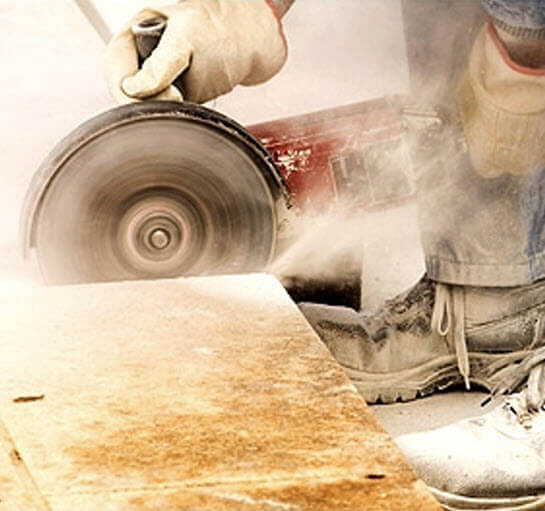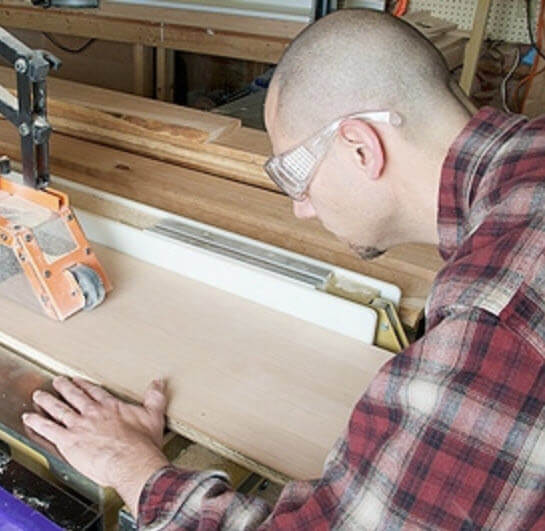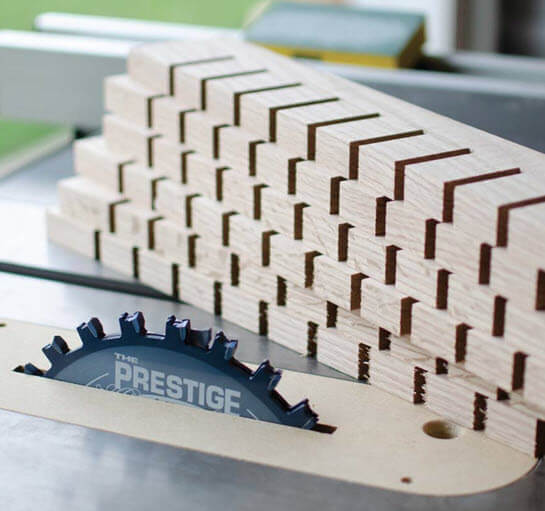
Jigsaw Blades - Not So Scary
Jigsaw blades are cutting tools designed specifically for use with a jigsaw, which is a versatile handheld power tool used for making intricate cuts in a variety of materials. Depending on their design, jigsaw blades can cut through wood, metal, plastic, and other materials.
A circular saw has a rotating round blade that cuts hardwood and softwood along a straight line. Whereas, a jigsaw has a reciprocating blade that cuts straight, curves, and intricate internal and external shapes. While a circular saw cuts through material quickly, the jigsaw is the more versatile and safe power tool.

Key Points About Jigsaw Blades
Material: Most jigsaw blades are made from high carbon steel. These are great blades for cutting wood, but bi-metal blades are recommended for cutting metal. Bi-metal blades have extremely hard steel teeth joined to a blade body of softer carbon steel. The high-strength teeth maintain an edge much longer than carbon steel, hile the carbon steel allows the blade to bend, somewhat, during use.
T-Shank vs U-Shank: T-Shank blades are more popular due to their tool-free, quick-change capability in many modern jigsaws, while U-Shank blades are found in older models. Some saws will accept either type of blade. Be sure the style of the blade you select is compatible with your jigsaw.
Tooth Spacing and Size: Fine-toothed blades are suitable for making cleaner cuts in harder materials or when precision is required. Coarse teeth, on the other hand, are used for faster cuts in softer materials.
The materials thickness is another point to consider when choosing blades. As a rule, at least three blade teeth should be simultaneously cutting the material at all times. This means thinner materials should be cut with a blade with as fine teeth as possible.
Timberline® woodcutting blades may have as many as 21 teeth per inch, while the metal-cutting blades may have up to 24 or more. The fewer the teeth, the faster the blade will cut. However, blades with fewer teeth also mean a rougher finish.
Reverse Tooth: These blades have teeth that point upwards (opposite of the cutting direction) and are used for cutting laminates or veneers to prevent chipping on the top surface.
Specialized Blades: There are blades designed for specific materials and purposes, such as blades for cutting ceramics or laminates.
Blade Length and Thickness: Longer blades are used for thicker materials, but they can be more prone to bending or deflecting, leading to less accurate cuts. Thicker blades can provide more stability but might not be suitable for intricate curves.
Using a Jigsaw Blade
When using a jigsaw blade, it's essential to choose the right blade for the material and desired cut type. Using the wrong blade can lead to rough cuts, quicker wear, or even blade breakage.
Safety: While a jigsaw is safer than a circular saw, all cutting tools should be treated with appropriate caution.
- Wear protective gear: Always wear safety glasses, earplugs, and a dust mask to protect your eyes, ears, and lungs from debris and noise.
- Secure the material: Clamp or secure the material you are cutting to prevent it from moving around while you work.
- Choose the right blade: Select the appropriate blade for the material you are cutting and make sure it is securely attached to the jig saw.
- Start slowly: Begin cutting at a slow speed and gradually increase the speed as you become more comfortable with the tool.
- Use both hands: Hold the jig saw with both hands and keep your fingers away from the blade.
- Avoid cutting through knots: If you are cutting wood, avoid cutting through knots as they can cause the blade to bind and kick back.
- Turn off the tool when not in use: Always turn off the jig saw and unplug it when you are finished using it.
Maintenance and Replacement: Blades become dull or damaged over time, so it's important to regularly inspect them and replace as needed for best performance.
Frequently Asked Questions About Jigsaw Blades
What materials can I cut with a jigsaw blade?
Jigsaw blades can cut a wide variety of materials including wood, metal, plastic, laminate, ceramic tile, and even thin sheet materials. The key is selecting the right blade type for the material you're working with.
What’s the difference between T-shank and U-shank jigsaw blades?
T-shank blades are designed for tool-free quick changes and are compatible with most modern jigsaws. U-shank blades are more common on older models and may require a tool for blade changes. Always check your jigsaw’s compatibility before purchasing blades.
How do I choose the right jigsaw blade for my project?
Consider the material, desired finish, and type of cut. For fine, clean cuts use fine-toothed blades; for fast rough cuts use coarse-toothed blades. Specialized blades are available for metal, laminate, ceramic, and other materials. Blade length and thickness also affect performance and stability.
How many teeth per inch (TPI) should my jigsaw blade have?
As a general rule, thinner materials require fine teeth (higher TPI), while thicker or softer materials can be cut with coarser teeth (lower TPI). Ensure at least three teeth are engaged with the material at all times to avoid chattering or poor cut quality.
When should I replace my jigsaw blade?
Replace your jigsaw blade if it becomes dull, chipped, bent, or if you notice it burning the material or making rough, uneven cuts. Dull blades can also overheat, causing damage to both your material and your tool.
Can I use a jigsaw for straight cuts?
Yes, but while a jigsaw can make straight cuts, it's better suited for curves and intricate shapes. For long, clean, straight cuts, a circular saw or track saw will usually give better results.
Why would I use a reverse-tooth jigsaw blade?
Reverse-tooth blades are excellent for cutting laminates, veneers, and surfaces where you want to avoid chipping on the top face of the material. The upward-pointing teeth cut on the downstroke, keeping the visible surface clean and smooth.
How do I prevent blade deflection when cutting thicker material?
Use a thicker, stiffer blade designed for straight cuts in thicker material, and let the saw do the work—don’t force it. Slower speeds and steady feed pressure will also help maintain accuracy and minimize blade bending.
Is a jigsaw safe for beginners?
Yes—jigsaws are one of the more beginner-friendly power tools. They offer good control and safety features, and their reciprocating blade action is less likely to cause kickback than rotary blades. Just remember to follow basic safety practices: secure your material, wear protective gear, and keep fingers clear of the blade path.
Can a jigsaw really cut "any shape I want"?
Almost! A jigsaw is fantastic for curves, circles, and intricate shapes—far more versatile than most saws. However, super-tight corners, complex inlays, or razor-sharp angles might require a little creative blade work or follow-up sanding. Think of the jigsaw as your freehand sketch tool in the workshop—it gives you flexibility, but sometimes perfection still takes a few extra steps.


 Router Bits
Router Bits Spektra Router Bits
Spektra Router Bits Saw Blades
Saw Blades Shaper Cutters
Shaper Cutters Boring & Drilling
Boring & Drilling




 CNC Router Bits
CNC Router Bits CNC Router Bit Sets
CNC Router Bit Sets CNC Machines
CNC Machines CNC Machine Accessories
CNC Machine Accessories Free Vectric® & Fusion 360™ CNC Files
Free Vectric® & Fusion 360™ CNC Files CNC Software
CNC Software CNC Plans Downloads
CNC Plans Downloads CNC Vacuum Table Vacs
CNC Vacuum Table Vacs  Laser Cutters Accessories
Laser Cutters Accessories Laser Cutters
Laser Cutters CNC Sanding Tools
CNC Sanding Tools

















































 Drilling & Screwdriving
Drilling & Screwdriving Filtration, Dust Extractors & Collectors
Filtration, Dust Extractors & Collectors Edge Banders
Edge Banders Joinery Machines
Joinery Machines Jointers & Planers
Jointers & Planers Material Handling
Material Handling Metalworking Tools
Metalworking Tools  Mobile Tool Bases & Universal Stands
Mobile Tool Bases & Universal Stands Oscillating Multi-Tools
Oscillating Multi-Tools Power Tool Accessories
Power Tool Accessories Routers & Shapers
Routers & Shapers Sanders & Polishers
Sanders & Polishers Saws
Saws Wood Turning Machines and Accessories
Wood Turning Machines and Accessories



















































































 Amana Tool
Amana Tool
 Sawstop
Sawstop
 Festool
Festool
 Woodpeckers
Woodpeckers
 Timberline
Timberline
 Stepcraft
Stepcraft
 A.G.E. Series
A.G.E. Series
 Fein
Fein
 Jet
Jet
 VECTRIC
VECTRIC
 Powermatic
Powermatic
 Laguna Tools
Laguna Tools Carbide 3d
Carbide 3d
 Onefinity CNC
Onefinity CNC
 Shaper
Shaper
 xTool
xTool
 AirWeights
AirWeights
 Panto Router
Panto Router
 Black Box Vac
Black Box Vac
 SST
SST
 Jessem
Jessem
 Donek Tools
Donek Tools











































































































